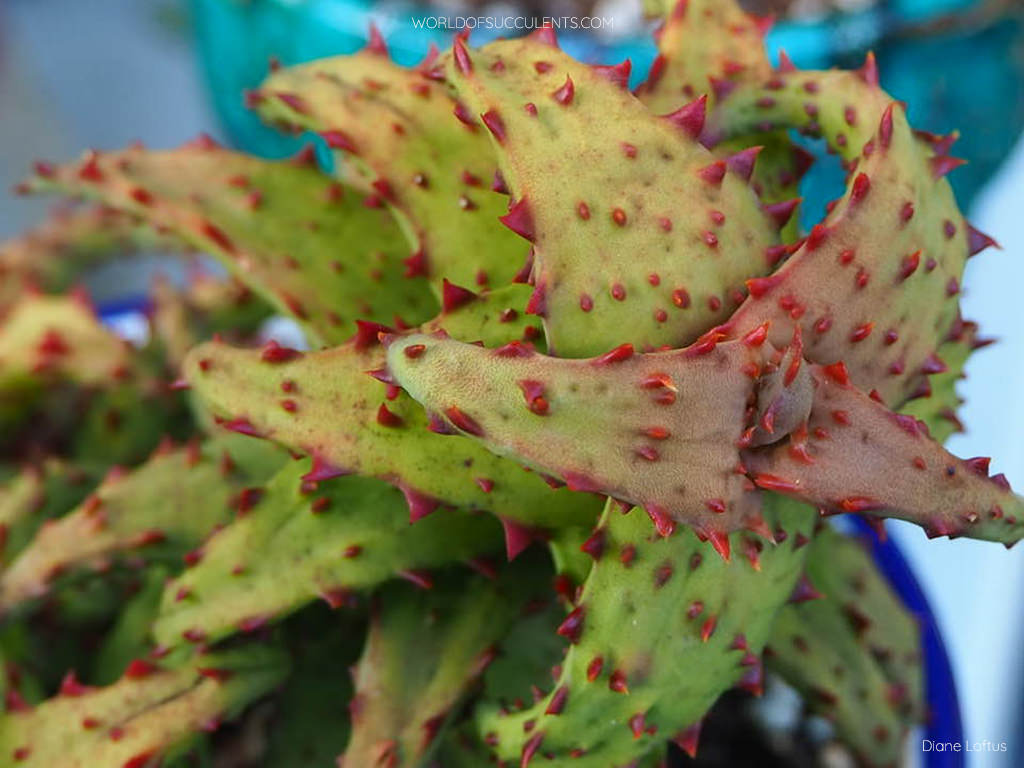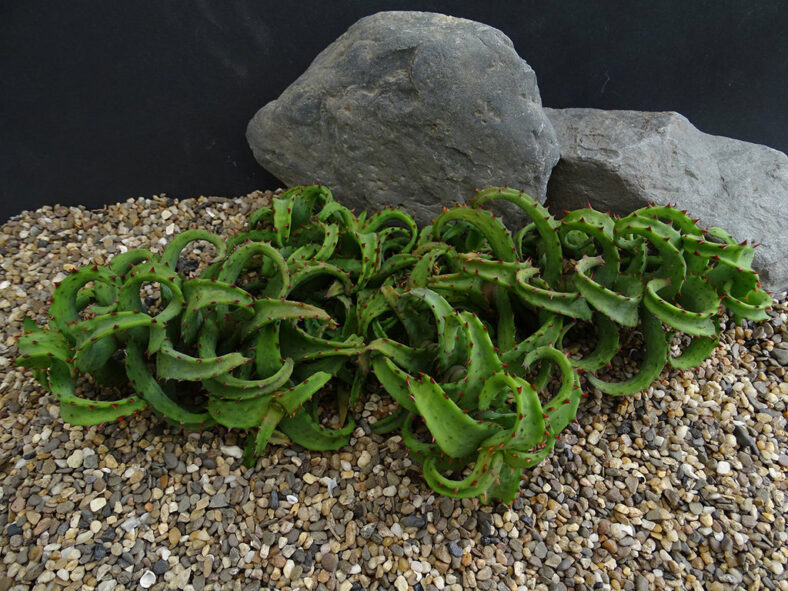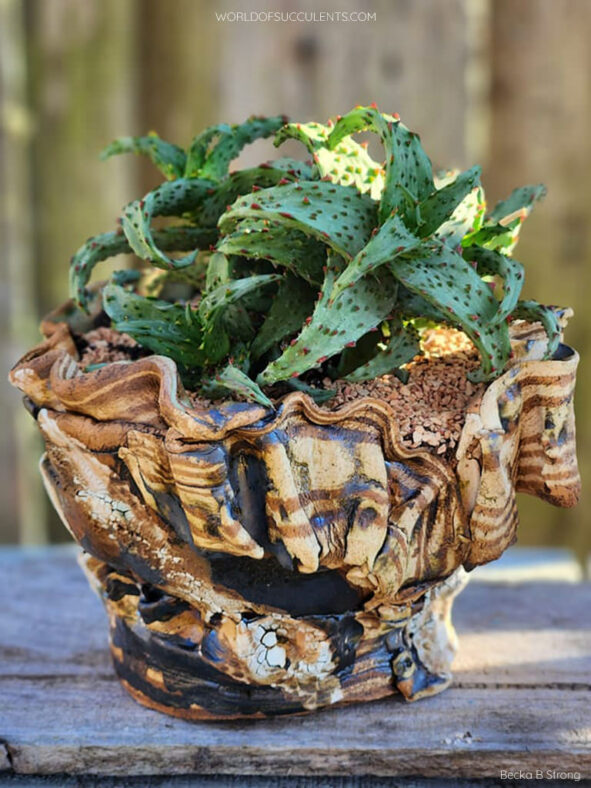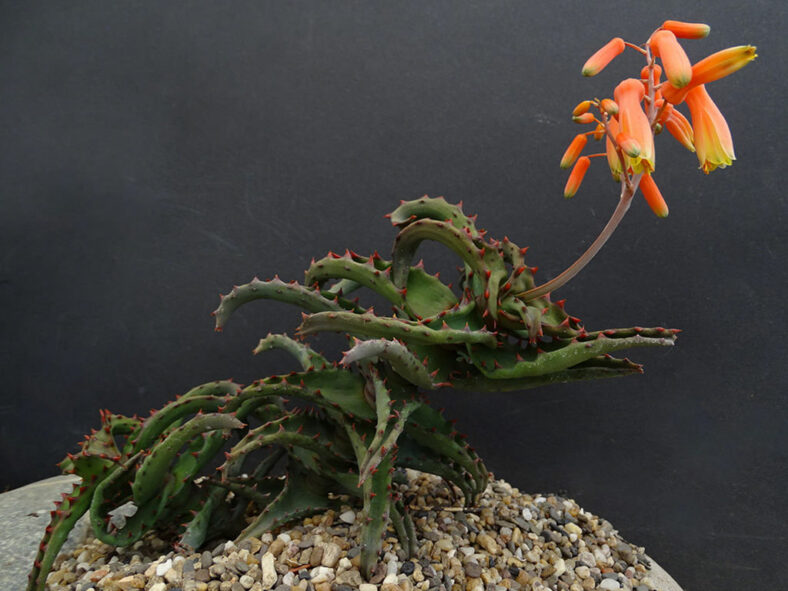Scientific Name
Aloe castilloniae J.-B.Castillon
Scientific Classification
Family: Asphodelaceae
Subfamily: Asphodeloideae
Genus: Aloe
Etymology
The specific epithet "castilloniae (pronounced kas-tee-LON-ee-ay)" honors Bernadette Castillon, a horticulturist specializing in Madagascan succulents at CB Succulentes on the French island of Réunion located in the Indian Ocean, and the wife of the French botanist Jean-Bernard Castillon, who first described the species in 2006.
Origin
Aloe castilloniae is a rare species native to southwestern Madagascar. It grows on porous calcareous sandstone from 330 to 980 feet (100 to 250 m) above sea level a few miles inland on the coastal-facing Plateau Mahafaly near Joffreville.
Description
Aloe castilloniae is a small, creeping succulent with leafy stems tipped by rosettes of olive green, recurved leaves with red teeth along margins and scattered red tubercles on both surfaces. It branches from the base, forming dense clusters with age. The stems slowly grow and can reach up to 16 inches (40 cm) in length. The number of tubercles varies widely from one specimen to the next. The leaves are triangular, measuring up to 2.4 inches (6 cm) long and 0.6 inches (1.5 cm) wide.
The flowers are constricted above the base, orange with a yellow tinge near the mouth, and appear in laxly flowered clusters on unbranched stalks, usually in fall and winter. The flower stalks can grow up to 2 inches (5 cm) tall.

How to Grow and Care for Aloe castilloniae
Light: When growing A. castilloniae indoors, place your plant near a window with plenty of bright indirect light. Rotate the pot once or twice a week so that all sides of the plant receive equal lighting. Outdoors provide light shade, especially during the hottest parts of the day.
Soil: Plant A. castilloniae in a well-drained soil mix formulated for succulents or make your own. Drainage is essential because too much moisture around roots can cause root rot.
Temperature: This succulent grows at its best between 50 to 85 °F (10 to 30 °C). When temperatures shift below 50 °F (10 °C), it is time to bring your plant back inside. A. castilloniae can withstand temperatures as low as 25 °F (-3.9 °C). USDA Plant Hardiness Zones 9b to 11b, 25 to 50 °F (-3.9 to 10 °C).
Watering: This succulent does need regular watering but is very tolerant of drought conditions for short periods. Water deeply, but only when the soil is dry. Cut back on watering during the winter months. Do not let water stand in the rosettes.
Fertilizing: A. castilloniae generally does not require fertilizer but may benefit from the extra nutrients. Feed with a fertilizer for succulents in spring and summer only. Be sure to follow the label directions.
Repotting: This plant is not particularly fast-growing and will rarely need repotting. To prevent it from becoming rootbound, repot it in the spring in a container a few inches larger in diameter every few years.
Propagation: Propagating A. castilloniae can be done using seeds or stem cuttings. Take cuttings from late spring to early summer. For best results, sow the seeds during the warm months.
Learn more at How to Grow and Care for Aloe.
Toxicity of Aloe castilloniae
A. castilloniae is not listed as toxic for people and pets.
Links
- Back to genus Aloe
- Succupedia: Browse succulents by Scientific Name, Common Name, Genus, Family, USDA Hardiness Zone, Origin, or cacti by Genus
Photo Gallery
Click on a photo to see a larger version.


